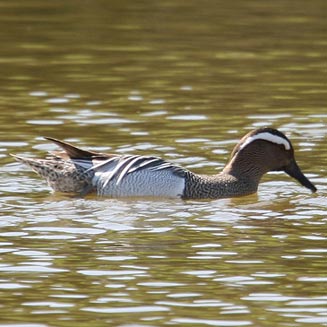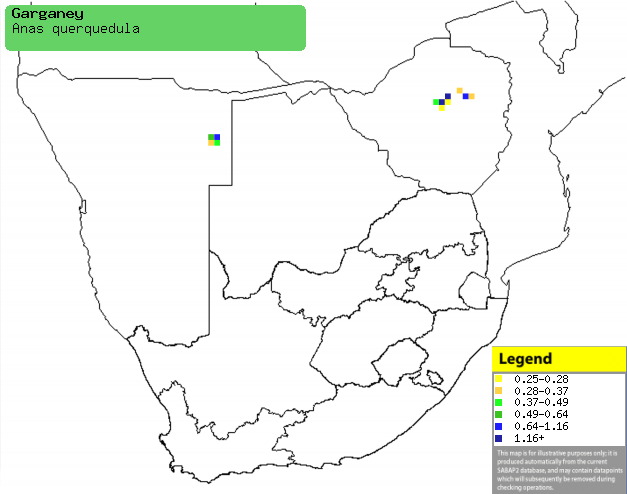|
Anas querquedula (Garganey)
Somereend [Afrikaans]; Zomertaling [Dutch]; Sarcelle
d'été [French]; Knäkente [German]; Marreco-europeu [Portuguese]
Life
> Eukaryotes >
Opisthokonta
> Metazoa (animals) >
Bilateria >
Deuterostomia > Chordata >
Craniata > Vertebrata (vertebrates) > Gnathostomata (jawed
vertebrates) > Teleostomi (teleost fish) > Osteichthyes (bony fish) > Class:
Sarcopterygii (lobe-finned
fish) > Stegocephalia (terrestrial
vertebrates) > Tetrapoda
(four-legged vertebrates) > Reptiliomorpha > Amniota >
Reptilia (reptiles) >
Romeriida > Diapsida > Archosauromorpha > Archosauria >
Dinosauria
(dinosaurs) > Saur
ischia > Theropoda (bipedal predatory dinosaurs) >
Coelurosauria > Maniraptora > Aves
(birds) > Order: Anseriformes
> Family: Anatidae
 |
|
|
Garganey, Tablas de Daimiel National Park, Spain.
[photo Mike Grimes
©] |
|
Distribution and habitat
Breeds in a broad band between 40-65° North from western
Europe to the Pacific, heading south in the non-breeding season to South-East
Asia and sub-Saharan Africa. Within southern Africa it is generally rare
in central Zimbabwe and north-eastern Namibia, while it is a rare vagrant to
southern Botswana and South Africa. It generally prefers shallow freshwater
wetlands with emergent vegetation, such as flood plains, shallow dams, pans and
sewage ponds.
|
 |
|
Distribution of Garganey in southern Africa,
based on statistical smoothing of the records from first SA Bird Atlas
Project (©
Animal Demography unit, University of
Cape Town; smoothing by Birgit Erni and Francesca Little). Colours range
from dark blue (most common) through to yellow (least common).
See here for the latest distribution
from the SABAP2. |
Movements and migrations
Mainly present in southern Africa in the period
from November-April.
Food
It mainly eats aquatic insects and their larvae, such as
molluscs, crustaceans, worms and leeches, as well as frog spawn, tadpoles and
fish. It does most of its foraging by swimming with its head underwater.
References
-
Hockey PAR, Dean WRJ and Ryan PG 2005. Roberts
- Birds of southern Africa, VIIth ed. The Trustees of the John Voelcker
Bird Book Fund, Cape Town.
|
